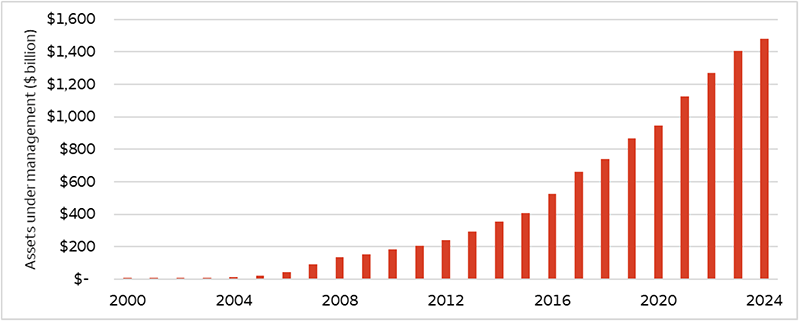April 1, 2025
Chao Ma, PhD, CFA, FRM; Global Portfolio and Investment Strategist
AI and cloud computing power private infrastructure
 Sources: Preqin and Wells Fargo Investment Institute. Data as of June 30, 2024. The assets under management is calculated based on all private infrastructure funds that Preqin sourced and classified as infrastructure funds. Excerpted from Investment Strategy report (March 24)
Sources: Preqin and Wells Fargo Investment Institute. Data as of June 30, 2024. The assets under management is calculated based on all private infrastructure funds that Preqin sourced and classified as infrastructure funds. Excerpted from Investment Strategy report (March 24)Private infrastructure investments have grown to nearly $1.5 trillion (from 2000 to June 30, 2024)
Infrastructure assets are the networks and systems that provide essential services, ranging from roads and bridges to ports and airports, utilities, and power transmission, as well as pipelines, telecommunication towers, and data centers.
The growth and adoption of new technologies, including cloud computing and artificial intelligence (AI), as well as the transition to clean and renewable energy, will require significant capital outlays. The World Bank’s Global Infrastructure Hub estimated that $51 trillion will be needed by 2040 to accelerate energy transition and support the digital economy.
What it may mean for investors
With growing government budget deficits and increasingly constrained public finances, we expect that private capital will play a greater role in infrastructure investments. According to Preqin, from 2020 to 2024, private infrastructure has raised $625 billion in capital and has accumulated $350 billion in dry powder that is ready to be invested.
As the chart shows, in the second quarter of 2024, private infrastructure reached nearly $1.5 trillion in assets under management. We believe this growth will continue and can offer attractive opportunities for long-term investors seeking relatively consistent returns that provide a hedge against rising inflation.
Alternative investments, such as hedge funds, private equity, private debt and private real estate funds are not appropriate for all investors and are only open to “accredited” or “qualified” investors within the meaning of U.S. securities laws.
Risk Considerations
Each asset class has its own risk and return characteristics. The level of risk associated with a particular investment or asset class generally correlates with the level of return the investment or asset class might achieve. Stock markets, especially foreign markets, are volatile. Stock values may fluctuate in response to general economic and market conditions, the prospects of individual companies, and industry sectors.
Alternative investments, such as hedge funds, private equity/private debt and private real estate funds, are speculative and involve a high degree of risk that is appropriate only for those investors who have the financial sophistication and expertise to evaluate the merits and risks of an investment in a fund and for which the fund does not represent a complete investment program. They entail significant risks that can include losses due to leveraging or other speculative investment practices, lack of liquidity, volatility of returns, restrictions on transferring interests in a fund, potential lack of diversification, absence and/or delay of information regarding valuations and pricing, complex tax structures and delays in tax reporting, less regulation and higher fees than mutual funds. Hedge fund, private equity, private debt and private real estate fund investing involves other material risks including capital loss and the loss of the entire amount invested. A fund's offering documents should be carefully reviewed prior to investing.
General Disclosures
Global Investment Strategy (GIS) is a division of Wells Fargo Investment Institute, Inc. (WFII). WFII is a registered investment adviser and wholly owned subsidiary of Wells Fargo Bank, N.A., a bank affiliate of Wells Fargo & Company.
The information in this report was prepared by Global Investment Strategy. Opinions represent GIS’ opinion as of the date of this report and are for general information purposes only and are not intended to predict or guarantee the future performance of any individual security, market sector or the markets generally. GIS does not undertake to advise you of any change in its opinions or the information contained in this report. Wells Fargo & Company affiliates may issue reports or have opinions that are inconsistent with, and reach different conclusions from, this report.
The information contained herein constitutes general information and is not directed to, designed for, or individually tailored to, any particular investor or potential investor. This report is not intended to be a client-specific suitability or best interest analysis or recommendation, an offer to participate in any investment, or a recommendation to buy, hold or sell securities. Do not use this report as the sole basis for investment decisions. Do not select an asset class or investment product based on performance alone. Consider all relevant information, including your existing portfolio, investment objectives, risk tolerance, liquidity needs and investment time horizon. The material contained herein has been prepared from sources and data we believe to be reliable but we make no guarantee to its accuracy or completeness.
Wells Fargo Advisors is registered with the U.S. Securities and Exchange Commission and the Financial Industry Regulatory Authority, but is not licensed or registered with any financial services regulatory authority outside of the U.S. Non-U.S. residents who maintain U.S.-based financial services account(s) with Wells Fargo Advisors may not be afforded certain protections conferred by legislation and regulations in their country of residence in respect of any investments, investment transactions or communications made with Wells Fargo Advisors.
Wells Fargo Advisors is a trade name used by Wells Fargo Clearing Services, LLC and Wells Fargo Advisors Financial Network, LLC, Members SIPC, separate registered broker-dealers and non-bank affiliates of Wells Fargo & Company.
